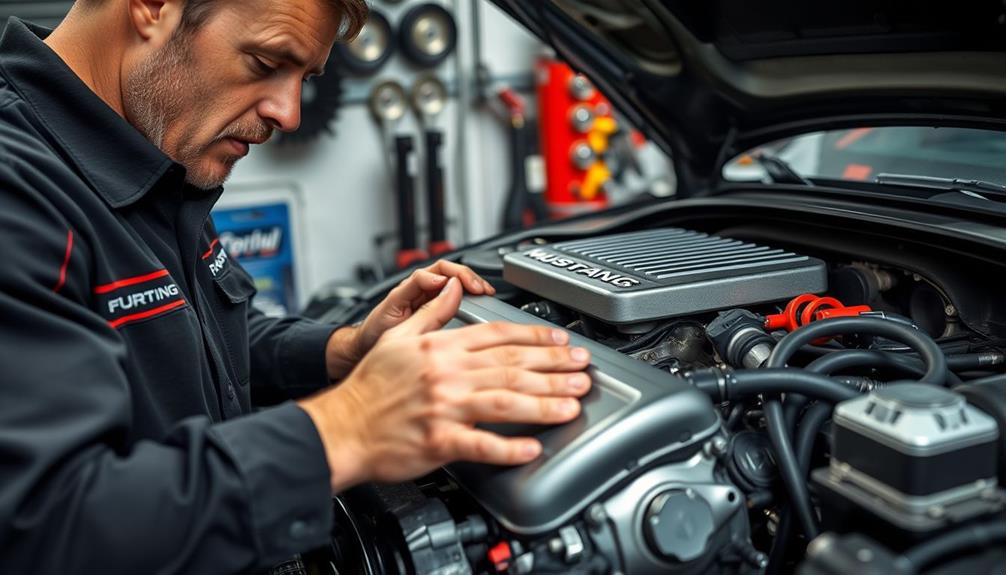Tuning your Ford Mustang GT is key to releasing its legendary power. Start with a custom ECU tune, which can boost your horsepower by 15 to 25. Adding a quality cold air intake can bring another 10 horsepower, enhancing throttle response and acceleration. Don't forget about exhaust upgrades; they can reduce backpressure and add up to 20 more horsepower. By optimizing the air-fuel mixture and ignition timing, you'll improve throttle response and fuel efficiency as well. Discovering the right upgrades is essential, so stick around to see how you can maximize your Mustang's performance even further.
Key Takeaways
- Tuning the Mustang GT optimizes air-fuel mixtures and ignition timing, increasing horsepower by 15-25 and enhancing overall performance.
- Adding a cold air intake system can improve airflow, yielding an additional 10 horsepower while reducing heat soak.
- Upgrading the exhaust system, including cat-back systems and long-tube headers, can provide 10-20 extra horsepower with proper tuning.
- Engine tuning can enhance throttle response, leading to quicker acceleration and better 0-60 times compared to stock performance.
- Proper tuning can also improve fuel efficiency by 5-10%, balancing power gains with economical driving benefits.
Understanding Mustang GT Tuning
When it comes to enhancing your Mustang GT's performance, understanding tuning is fundamental. Tuning primarily involves adjusting the engine's air-fuel mixture and ignition timing to improve performance.
With the stock 2021 Mustang GT equipped with a 5.0-liter Coyote V8 engine, you're starting with around 450 horsepower and 410 lb-ft of torque. However, by implementing a custom ECU tune, you can gain an additional 15 to 25 horsepower or even more, depending on the quality of the tune and any other modifications you've made.
To maximize the benefits of tuning, consider adding performance parts like a cold air intake. This can improve airflow into the engine and complement your tuning efforts. In one test, a cold air intake alone yielded an impressive 10 horsepower gain.
It's also important to perform dyno testing to evaluate the effectiveness of your tuning modifications. This testing provides significant data on your Mustang GT's horsepower and torque curves, ensuring that you're making the best performance adjustments.
Key Performance Upgrades

When you're looking to boost your Mustang GT's performance, there are several key upgrades to contemplate.
Engine tuning enhancements, a high-performance cold air intake, and an upgraded exhaust system can greatly elevate your ride's horsepower and efficiency.
Let's explore how each of these modifications can transform your driving experience.
Engine Tuning Enhancements
Engine tuning enhancements for the Ford Mustang GT can dramatically elevate your performance, making every drive more exhilarating. By opting for an engine tuning solution, like a Steeda tune, you could see substantial horsepower gains.
For instance, a stock Coyote engine typically produces about 410.8 horsepower at the wheels, but post-tuning, that number can climb to around 425 horsepower. This increase of 24.1 horsepower, along with a boost of 21.8 lb-ft of torque, showcases the effectiveness of engine tuning.
You'll notice a significant improvement in mid-range and top-end powerband performance, translating to quicker acceleration and a more engaging driving experience.
What's great is that even minimal modifications can yield impressive results, making your muscle car not just faster, but also more reliable.
With the right tuning adjustments, you can reveal the full potential of your Mustang GT, ensuring it delivers peak performance on every drive.
Cold Air Intake Benefits
Upgrading your Ford Mustang GT with a cold air intake system can greatly enhance performance, complementing the gains achieved through engine tuning. Installing a quality cold air intake, like the Steeda ProFlow Open Cold Air Intake, markedly improves engine airflow. You can expect a notable horsepower increase—testing has shown gains of around 10 horsepower just from this upgrade alone.
Additionally, understanding the importance of a budget for modifications can help you prioritize upgrades that provide the best performance gains for your investment.
One of the key benefits of a cold air intake is its ability to reduce heat soak. By drawing in cooler, denser air, it guarantees that your engine maintains peak performance and burns fuel more efficiently. This improved intake efficiency not only boosts horsepower but also enhances throttle response, making your Mustang feel more responsive during acceleration.
When combined with tuning modifications, a cold air intake can lead to impressive results. In tests, a combination of a tune and intake upgrade yielded a total horsepower gain of 24.1 and a torque increase of 21.8 lb-ft.
Plus, these systems replace restrictive factory airboxes, improving mid-range and top-end powerband performance. With a cold air intake, you're well on your way to revealing your Mustang's full potential.
Exhaust System Upgrades
A well-designed exhaust system can transform your Ford Mustang GT's performance and driving experience. Upgrading to a high-performance exhaust system considerably enhances engine output by improving exhaust flow and reducing backpressure. You can expect gains of up to 10-15 horsepower with a quality cat-back system from brands like Borla or MagnaFlow.
These systems not only boost power but also deliver that iconic, aggressive exhaust note that turns heads.
If you're looking for even more horsepower, consider installing aftermarket long-tube headers. These provide better exhaust scavenging, potentially adding another 15-20 horsepower when paired with a proper tune.
Additionally, opting for a lightweight exhaust system made from materials like stainless steel or titanium can reduce your Mustang's overall weight, leading to improved acceleration and handling.
Keep in mind that upgrading to a performance exhaust often requires tuning adjustments to fully capitalize on the power and efficiency benefits.
Benefits of Engine Tuning

When you tune your Mustang GT's engine, you can release increased horsepower output that transforms your driving experience.
You'll notice improved throttle response and enhanced fuel efficiency, making your rides not just faster but also more enjoyable.
With the right tuning, your Mustang can truly reach its full potential on the road.
Increased Horsepower Output
Tuning the Ford Mustang GT can release impressive gains in horsepower and torque, transforming your driving experience. With a Steeda tune, you can expect an increase of 15 horsepower, pushing your total output to a thrilling 425 horsepower at the wheels. This tuning reveals the performance potential that factory settings often leave on the table.
If you further enhance your setup with a Steeda ProFlow Open Cold Air Intake after tuning, you could add an extra 10 horsepower, bringing your total to an impressive 434.9 horsepower.
Combining these modifications results in a remarkable increase of 24.1 horsepower and 21.8 lb-ft of torque, showcasing how effective tuning can be. These enhancements improve mid-range and top-end powerband performance, leading to quicker acceleration and a more exhilarating driving experience.
Whether you’re cruising through city streets or taking on winding roads, tuning your Mustang GT guarantees you’re getting the most out of your muscle car. By customizing your Mustang GT’s engine, exhaust, suspension, and more, you can enhance its power, performance, and agility. And when it comes to tuning your muscle car, the expertise of a professional can make all the difference. For those looking to take their customization to the next level, consider exploring Ford Falcon tuning options for even more possibilities and performance enhancements.
Improved Throttle Response
Enhancing your Mustang GT's throttle response through engine tuning can dramatically change how your car feels on the road.
By optimizing the air-fuel mixture and ignition timing, you'll notice a swift and responsive acceleration every time you press the pedal. This tuning not only eliminates factory restrictions but also allows your engine to breathe more freely, resulting in improved performance.
Here are four key benefits of improved throttle response:
- Quicker Acceleration: Experience a noticeable reduction in lag, especially during quick acceleration scenarios.
- Enhanced Power Band: Enjoy a more responsive engine across both low and high RPMs, providing a thrilling dynamic driving experience.
- Better 0-60 Times: Performance tests show that tuned Mustangs achieve superior acceleration, showcasing the effectiveness of tuning.
- Overall Performance Boost: A well-executed tune translates to a more exhilarating driving experience, revealing your car's full potential.
With enhanced throttle response, your Mustang GT will transform into a more agile and engaging machine, making every drive feel like a true performance adventure.
Enhanced Fuel Efficiency
Maximizing your Mustang GT's fuel efficiency through engine tuning can lead to significant savings at the pump. By optimizing air-fuel mixtures, you'll enhance combustion efficiency, potentially improving overall fuel economy.
A properly tuned Mustang GT can achieve fuel efficiency improvements of 5-10%, especially during highway driving. You'll notice better throttle response and reduced engine load, making your drives not just thrilling but economical as well.
Adjusting ignition timing during tuning allows for more complete combustion, which means less fuel is wasted. Additionally, incorporating a cold air intake system can help lower intake temperatures, enabling your engine to operate more efficiently and further improving fuel consumption.
For daily drivers, utilizing performance tunes specifically tailored for fuel economy strikes a perfect balance, maintaining the power you love while optimizing miles per gallon. This approach guarantees that you don't have to sacrifice performance for efficiency.
With these tuning adjustments, you can enjoy the exhilarating experience of driving a Mustang GT while minimizing your fuel expenses. So, invest in tuning today and experience the dual benefits of performance and enhanced fuel efficiency!
Essential Tuning Tools

When it comes to enhancing your Ford Mustang GT's performance, having the right tools is vital. Investing in quality equipment will help you effectively implement tuning modifications and truly release the power of your muscle car.
Here are four must-have tuning tools:
- OBD-II Scanner: This device allows you to read and clear error codes while monitoring real-time engine data, giving you valuable insights into your vehicle's performance.
- Dyno: A reliable dynamometer is essential for accurately measuring horsepower and torque gains after tuning modifications, guaranteeing you know exactly how much power you're gaining.
- Performance Tuning Software: A good handheld tuner or software is necessary for adjusting your Mustang's ECU settings. This enables you to fine-tune fuel maps and ignition timing, maximizing your car's power and efficiency.
- Wideband Oxygen Sensor Gauge: This gauge monitors air-fuel ratios during tuning. It guarantees your engine runs at its best, preventing damage from running too lean or too rich, especially when paired with a cold air intake system.
With these vital tuning tools, you're well-equipped to enhance your Mustang's performance!
Common Mistakes to Avoid

Tuning your Ford Mustang GT can be a thrilling experience, but it's easy to make mistakes that hinder your results.
One common error is failing to properly tune your Mustang after modifications. For instance, you could miss out on a significant 15 horsepower gain from just a Steeda tune. Ignoring cold air intake systems is another pitfall; installing a Steeda ProFlow Open Cold Air Intake can give you a documented 10 horsepower boost.
Monitoring oil temperatures during dyno tests is essential too. If you overlook this, you may end up with inaccurate assessments of your engine's performance, which can stymie your tuning efforts.
Also, don't skimp on quality parts and tuning services. A safe tuning approach enhances performance while maintaining engine integrity.
Lastly, avoid rushing into performance upgrades. Gradual modifications can lead to a total improvement of 24.1 horsepower and 21.8 lb-ft torque, optimizing your Mustang's potential.
Real-World Performance Results

Real-world performance results from tuning your Ford Mustang GT can be impressive and rewarding.
When you invest in tuning, you reveal the true potential of your V8 engine and experience noticeable enhancements.
Here's what you can expect:
- Horsepower Increase: A stock 2021 Mustang GT produces around 410.8 horsepower. With a Steeda tune, you'll see that jump to 425 horsepower, gaining 15 horsepower right off the bat.
- Enhanced Air Intake: Adding a Steeda ProFlow Open Cold Air Intake boosts total output to 434.9 horsepower at the wheels, showcasing an impressive gain of 24.1 horsepower overall.
- Torque Boost: You'll also notice a significant increase of 21.8 lb-ft of torque, improving your driving experience in various conditions.
- Improved Performance: Real-world tests highlight better mid-range and top-end power, making your Mustang not just faster but also more engaging to drive.
Frequently Asked Questions
How Much Is the Hennessey Mustang Gt?
The Hennessey Mustang GT upgrade costs around $24,999 for the impressive 850 HP package. It markedly boosts performance, adding a supercharger and unique features, backed by a 2-year warranty for your peace of mind.
How Much Horsepower Can You Get Out of a Mustang Gt?
You can get around 410 horsepower from a stock Mustang GT. With tuning and modifications, like a cold air intake, you can push that number to over 430 horsepower, greatly enhancing your driving experience.
How Do I Get More Power Out of My Mustang Gt?
To really kick it up a notch, you should consider installing a performance tune, adding a cold air intake, and upgrading the exhaust system. These tweaks will boost your Mustang GT's power and performance considerably!
How Much HP Can a Tune Add to a Mustang Gt?
A tune can add about 15 horsepower to your Mustang GT's stock output. With a cold air intake, you might see a total gain of around 24.1 horsepower, enhancing both performance and driving experience greatly.
Conclusion
In the grand symphony of muscle car performance, tuning your Ford Mustang GT is like adding the perfect crescendo. By embracing the right upgrades and tools, you're not just enhancing horsepower; you're orchestrating a thrilling driving experience that'll leave you breathless. Remember, steering clear of common pitfalls keeps the ride smooth. So, release that legendary power and let your Mustang GT sing its heart out on the open road—it's time to turn heads and feel the excitement!









